Ukraine’s wartime winter: Which energy facilities are at risk?
Russian attacks have destroyed at least 40 percent of Ukraine’s energy facilities since the war began in February.
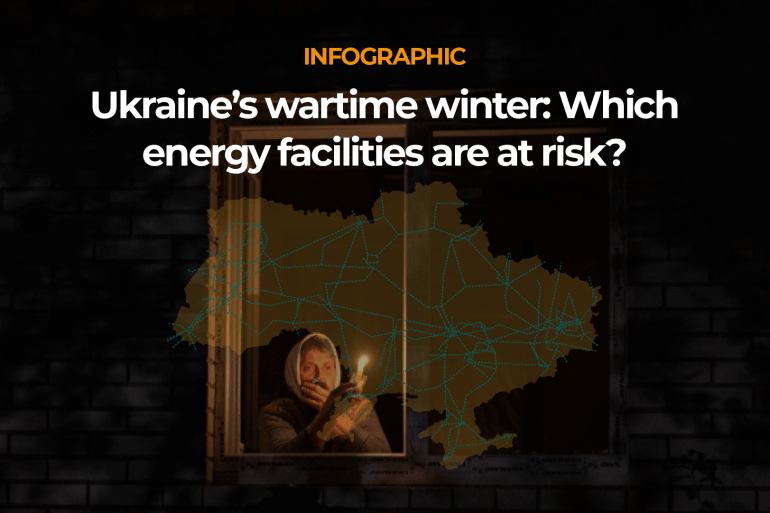
Ukraine is bracing for more emergency blackouts amid bitterly cold conditions, following a series of Russian attacks on energy facilities.
Since October 10, seven waves of attacks have killed civilians and destroyed or damaged houses, power stations and other infrastructure needed to keep millions of Ukrainians safe from winter.
Keep reading
list of 4 itemsRussian attacks on Ukraine’s Kharkiv region kill at least 11 people
Russia-Ukraine war: List of key events, day 815
Russian court seizes two European banks’ assets amid Western sanctions
Depending on the facility and scale of damage, the time it takes to repair Ukraine’s infrastructure ranges from hours or weeks to months or years.
Power lines are usually back up and running within days, but in wartime, fixing generating facilities and substations could take much longer.
“Ukraine’s energy system was constructed in Soviet times, same as the Russian ones. Russian engineers took part in its building. They know how it operates and now they are the ones consulting the Russian military on how to destroy it,” Antonina Antosha, spokesperson at DTEK, Ukraine’s largest energy firm, told Al Jazeera.
“These people used to be our colleagues. Now they are our enemies. Now they are war criminals. Again, the most vital issue in this situation is [obtaining] the necessary equipment and whether it is in stock.”
Bracing for the worst of winter
Kyiv’s Western allies say assaults on critical sites are designed to weaponise the winter.
Entire cities have been left without heat and water.
Ukrainian families are using sleeping bags to stay warm, surgeries in hospitals are being performed by phone flashlight, and people are trying to find spots in cities where they can charge their phones.
“On November 23, when we had severe attacks on our energy infrastructure, my friends and family didn’t have electricity or a mobile connection for more than 36 hours,” Maryna Ilchuk, a lawyer who advises domestic and foreign companies in the energy, oil and gas sectors, told Al Jazeera.
“A neighbour of my parents was stuck in a small elevator for 20 hours because there was an electricity outage,” said Ilchuk, who is also a board member at the Women’s Energy Club of Ukraine.
Ukraine has a mean winter.
From December to March, temperatures can drop as low as -10 Celsius (14 Fahrenheit) in the north. By comparison, winter temperatures in London drop to average lows of 5C (41F) and in New York to average lows of -3C (27F).
In a race to avoid a humanitarian crisis, officials are setting up shelters and providing emergency heat and water to citizens as the freezing cold sets in. International aid efforts are focused on ensuring Ukraine has generators and transformers.
“Before the war, Ukrainians had stable electricity and heat supply all day every day. However, this winter will be the toughest one in the history of Ukraine’s independence,” Antosha said.“[Russian President Vladimir] Putin could not gain victory on the battlefield so he is trying to cause a humanitarian catastrophe right in the middle of Europe.”
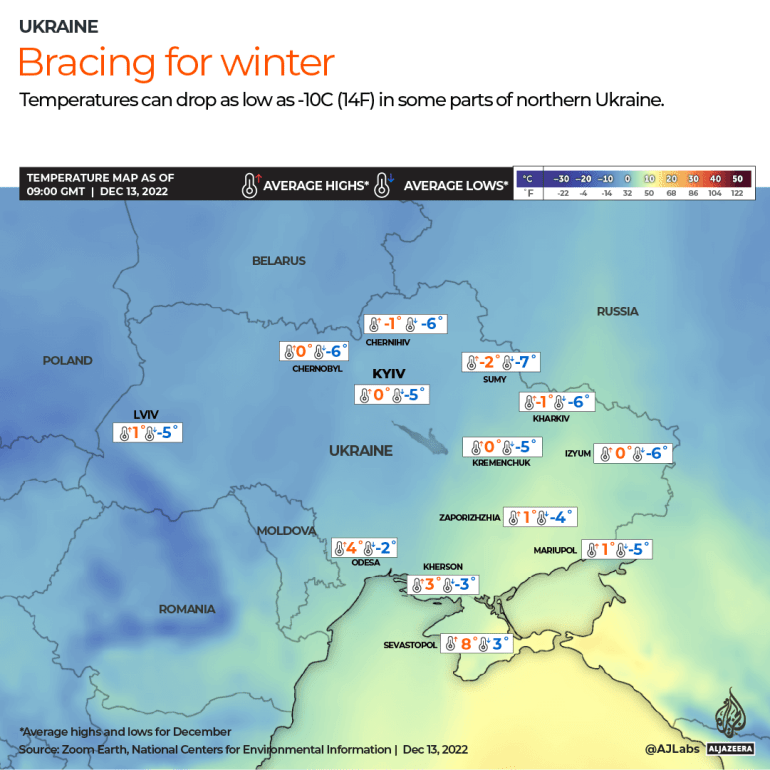
Wartime energy demand
Volodymyr Kudrytskyi, the head of Ukrenergo, Ukraine’s national electricity transmission operator, described the damage to power-generating facilities as “colossal”.
Since the start of the war, Ukraine’s energy generation has declined.
Demand fell in the first week of the war by about 30 percent, according to the International Energy Agency (IEA) and Ukrenergo, partly because a number of Ukraine’s nuclear reactors were disconnected from the grid when Russia invaded.
The drop was sharpest in nuclear energy, which powers more than half of Ukraine’s electricity.
In late November, Ukrenergo imposed emergency blackouts on Ukrainians and efforts to repair damaged infrastructure were set back. Several power stations conducted emergency shutdowns.
The destruction means electricity demand cannot be met, especially as it increases with snowy weather setting in.
“That is why emergency power outages are implemented for repair work and rolling blackouts – for holding back consumption,” said Antosha.
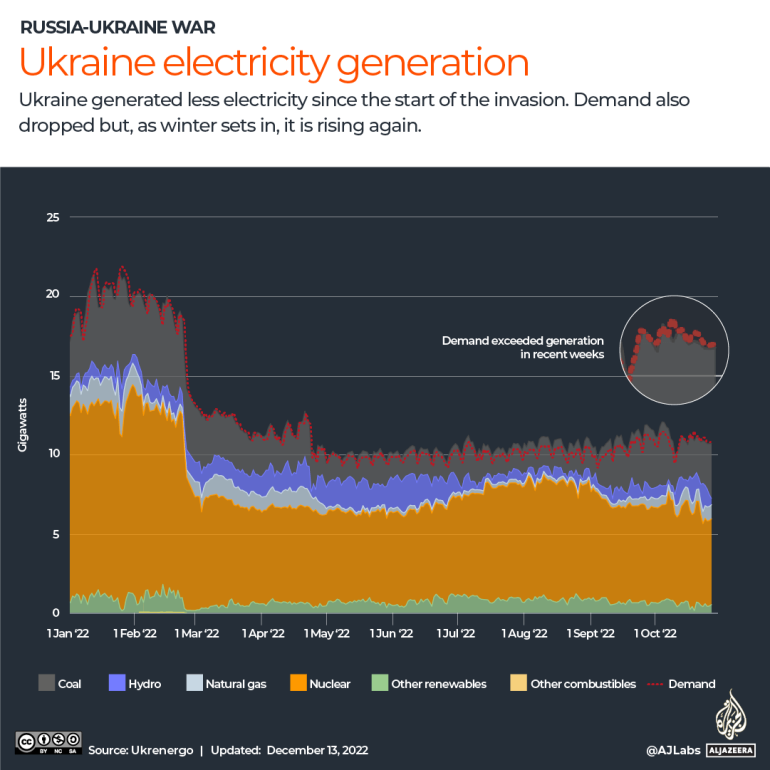
Ukraine’s power stations
In 2021, more than half (55.5 percent) of Ukraine’s electricity was produced with nuclear power, followed by coal (23.6 percent), hydropower (6.7 percent) and gas (6.6 percent).
Below is an interactive map of Ukraine’s operational power stations:
According to the British analytics and consulting company GlobalData, the total capacity of Ukraine’s coal power plants is 21,417 megawatts (MW), while nuclear is 13,835 MW, gas 9,681 MW, hydropower 6,033 MW, solar PV 5,888 MW, onshore wind 1,688 MW, biopower 122 MW and oil 18 MW.
Before the war, the average Ukrainian home used about 3,000 kilowatt hours (kWh) of energy a year. With that in mind, the Zaporizhzhia Nuclear Power Plant, Ukraine’s and Europe’s largest nuclear facility, has a total capacity of 5,700 MW, enough for about four million homes.
Why is the energy infrastructure being attacked?
Attacks on Ukraine’s energy infrastructure began in early October.
“October 10 is important to mention, because it’s the beginning of the heating season,” said Ilchuk.
“We assumed this is why Russia started attacks on the energy infrastructure exactly at the beginning of October. They could have started them before, but the final aim of the attacks is to make civilians suffer and to force more people to flee from the country, because it’s unbearable to live under conditions like this,” she said.
Ukrenergo’s chief, Kudrytskyi, said in November that “virtually all” large non-nuclear power stations had been hit by Russian missile attacks.
According to DTEK, Ukraine’s largest energy company, missiles are targeting high-voltage substations and power stations.
Some of the infrastructure affected includes thermal power plants operated by DTEK, two of which have been seized by Russians while the other six were damaged by missile attacks but have since been restored.
Ilchuk told Al Jazeera that attacks on substations are intentional.
“By hitting substations and also those high-voltage pipelines, the Russians realise that it will end up causing blackouts because some regions are isolated from the others,” she said. “Electricity deficient areas are isolated from electricity proficient areas. What happened on November 23 is that our transmission system operator didn’t call it a complete blackout, but it was a systematic emergency.
“The protection system automatically shut down several units at two nuclear power plants as they were producing electricity, but there was no technical possibility to transmit this electricity. And, it’s a fact that electricity has to be consumed at the very moment that is being produced unless we have battery storages.”
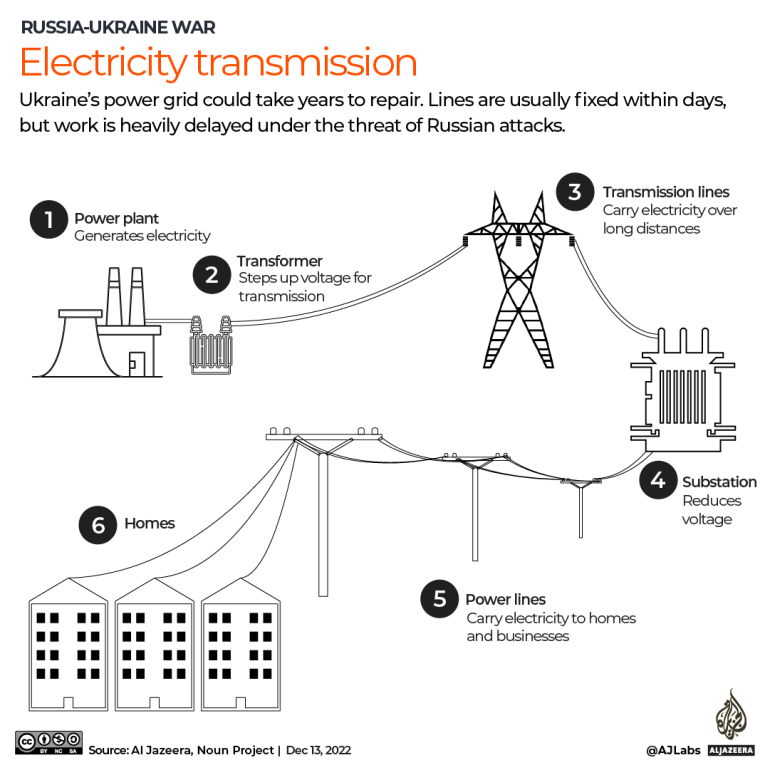
Are nuclear power plants at risk?
Ukraine has 15 nuclear reactors across four nuclear power plants (NPPs), with an operable capacity totalling 13,100 MW.
Zaporizhzhia Nuclear Power Plant is the largest unit, with 5,700 MW of capacity. It constitutes nearly half of the total electricity generated by Ukraine’s NPPs. Before Moscow’s invasion, it accounted for one-fifth (20 percent) of Ukraine’s total electricity.
Zaporizhzhia NPP is Europe’s largest nuclear facility, and has been under Russian control since early on in the war.
“Since the initial attack on 3 March, the grid connection was severed multiple times, and the plant no longer injects power into the Ukrainian grid as of 25 August,” said IEA’s Programme Manager for Russia, Caspian and Black Sea, Talya Vatman.
Repeated shelling and attacks at the plant have led to many close calls, with risks of a radioactive leak, according to United Nations experts. A barrage of shelling in mid-November fell near reactors at Zaporizhzhia and damaged a radioactive waste storage building.
Khmelnytskyi NPP was attacked last month and lost connection from the power grid on November 15 after the site’s four operating lines went down.
According to IAEA Director General Rafael Grossi, Khmelnytskyi NPP had to rely on backup diesel generators for nine hours on the day of the attack. However, diesel generators are prone to failure in colder temperatures, increasing risks for nuclear plants, according to DTEK energy.
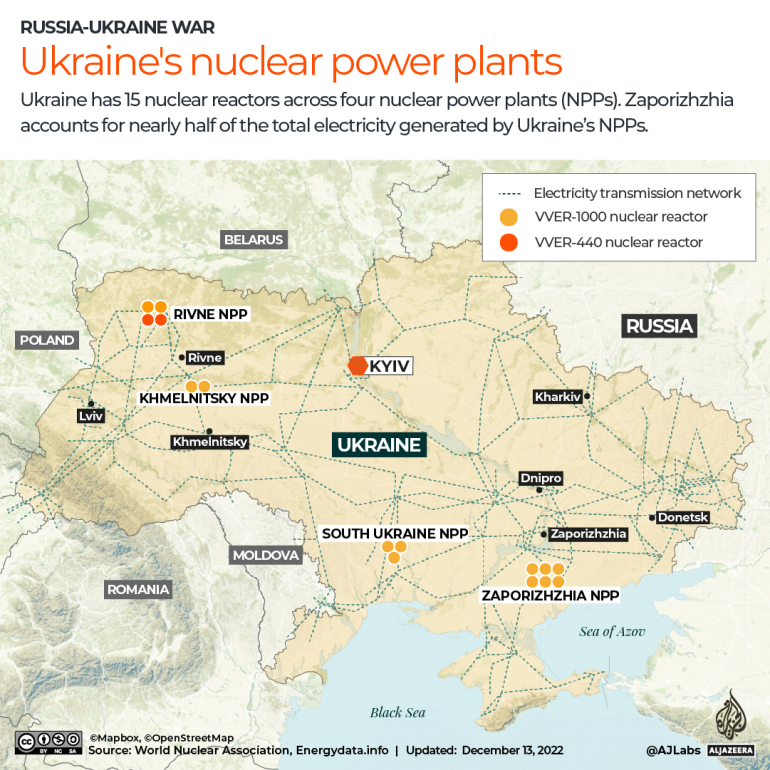
Reparations for damage
On November 14, the United Nations General Assembly adopted a resolution calling for Russia to pay reparations for the damage and loss of life during the conflict in Ukraine.
In total, 94 of the assembly’s 193 members voted in favour of the resolution. However, the move was perceived as mostly symbolic.
“We understand a new precedent could be created and we also understand that Russia has abandoned many international organisations because they are not forced under international court to pay compensation,” said Ilchuk.
“In March Ukraine adopted internal legislation on approval of the procedure for determining the damage and losses caused to Ukraine as a result of the armed oppression at the hands of the Russian Federation.”
Looking ahead, some observers say the war has fuelled a global push towards renewables as many countries seek security and price stability.
Ukraine has about 10,000 MW of installed renewable energy capacity with a system that has been in place for many years to incentivise renewables.
“After the current destruction and power outages, lots of people started Googling to find out more about solar panels,” says Ilchuk. “Before it was more fancy, but nowadays people have to be energy efficient and independent. They have to be aware of energy consumption.”
